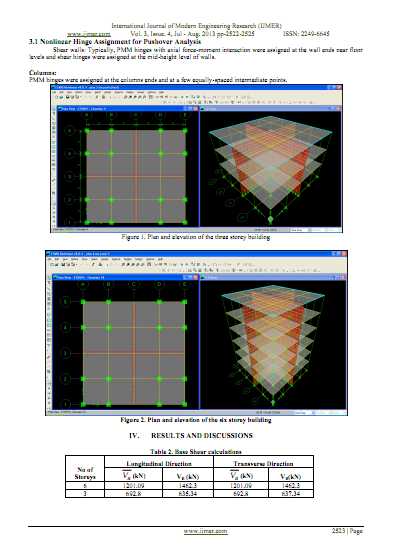Performance Based Evaluation of Shear Walled RCC Building by Pushover Analysis
ABSTRACT:
As the world move towards the implementation of Performance Based Engineering philosophies in seismic
design of Civil Engineering structures, new seismic design provisions require Structural Engineers to perform both linear and nonlinear analysis for the design of structures. In the present work three storey and six storey building models with plus shape Shear wall have been considered. Equivalent static and response spectrum methods are carried out as per IS:1893 (Part 1) -2002 using finite element analysis software ETABS v9.1.1. Seismic performance is assessed by pushover analysis as per ATC-40 guidelines for earthquake zone V in India. The paper also deals with the effect of the variation of the building height on the structural response of the shear wall. This paper highlights the accuracy of Push over analysis in comparison with the most commonly adopted Response Spectrum Analysis and Equivalent Static Analysis.
Keywords: Equivalent Static method, Pushover Analysis, Response Spectrum Analysis, Shear Wall, Storey height.

I. INTRODUCTION
Recently there has been a considerable increase in the tall buildings both residential and commercial and the modern trend is towards more tall and slender structures. Thus the effects of lateral loads like wind loads, earthquake loads and blast forces are attaining increasing importance and almost every designer is faced with the problems of providing adequate strength and stability against lateral loads. This is the new development as the earlier building designers designed the buildings for vertical loads and as an afterthought checked the final design for lateral loads as well. Now the situation is quiet different and a clear understanding of effect of the lateral loads on the building and the behavior of various components under these loads is essential.
Structural design of buildings for seismic loading is primarily concerned with structural safety during major earthquakes, but serviceability and the potential for economic loss are also of concern. Seismic loading requires an understanding of the structural behavior under large inelastic deformations. Behavior under this loading is fundamentally different from wind or gravity loading, requiring much more detailed analysis to assure acceptable seismic performance beyond the elastic range. Some structural damage can be expected when the building experiences design ground motions because almost all building codes allow inelastic energy dissipation in structural systems.
II. OBJECTIVES
The main objectives of present study include: 1. The effect of Plus shaped shear wall on structural response under seismic loading. 2. Analysis of framed structures using Static Non linear Pushover analysis, Response Spectrum Method and Equivalent
Static Method.
III. STRUCTURAL MODELLING
The finite element analysis software ETABS v 9.1.1 is utilized to create 3D model and run all analyses. The software is able to predict the geometric nonlinear behavior of space frames under static or dynamic loadings, taking into account both geometric nonlinearity and material inelasticity. The software accepts static loads (either forces or displacements) as well as dynamic (accelerations) actions and has the ability to perform eigen values, nonlinear static pushover and nonlinear dynamic analyses.
Download
*